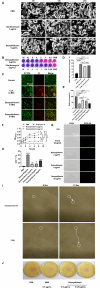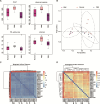Deoxyshikonin: a promising lead drug grass against drug resistance or sensitivity to Helicobacter pylori in an acidic environment
- PMID: 39171918
- PMCID: PMC11460997
- DOI: 10.1128/aac.00959-24
Deoxyshikonin: a promising lead drug grass against drug resistance or sensitivity to Helicobacter pylori in an acidic environment
Erratum in
-
Erratum for Xu et al., "Deoxyshikonin: a promising lead drug grass against drug resistance or sensitivity to Helicobacter pylori in an acidic environment".Antimicrob Agents Chemother. 2025 Mar 5;69(3):e0184024. doi: 10.1128/aac.01840-24. Epub 2025 Jan 27. Antimicrob Agents Chemother. 2025. PMID: 39868795 Free PMC article. No abstract available.
Abstract
Helicobacter pylori (H. pylori) is closely associated with the diseases such as gastric sinusitis, peptic ulcers, and gastric adenocarcinoma. Its drug resistance is very severe, and new antibiotics are urgently needed. Nine comfrey compounds were screened by antimicrobial susceptibility testing, among which deoxyshikonin had the best inhibitory effect, with a minimum inhibitory concentration (MIC) of 0.5-1 µg/mL. In addition, deoxyshikonin also has a good antibacterial effect in an acidic environment, it is highly safe, and H. pylori does not readily develop drug resistance. Through in vivo experiments, it was proven that deoxyshikonin (7 mg/kg) had a beneficial therapeutic effect on acute gastritis in mice infected with the multidrug-resistant H. pylori BS001 strain. After treatment with desoxyshikonin, colonization of H. pylori in the gastric mucosa of mice was significantly reduced, gastric mucosal damage was repaired, inflammatory factors were reduced, and the treatment effect was better than that of standard triple therapy. Therefore, deoxyshikonin is a promising lead drug to solve the difficulty of drug resistance in H. pylori, and its antibacterial mechanism may be to destroy the biofilm and cause an oxidation reaction.
Keywords: Helicobacter pylori; acidic environment; deoxyshikonin; inhibitory action; lead drug.
Conflict of interest statement
The authors declare no conflict of interest.
Figures







Similar articles
-
Anti-Helicobacter pylori activities of Chenopodium ambrosioides L. in vitro and in vivo.World J Gastroenterol. 2015 Apr 14;21(14):4178-83. doi: 10.3748/wjg.v21.i14.4178. World J Gastroenterol. 2015. PMID: 25892867 Free PMC article.
-
Dynamic colonization of Helicobacter pylori in human gastric mucosa.Scand J Gastroenterol. 2008;43(2):178-85. doi: 10.1080/00365520701675965. Scand J Gastroenterol. 2008. PMID: 17918004
-
Helicobacter pylori Biofilm Formation and Its Potential Role in Pathogenesis.Microbiol Mol Biol Rev. 2018 May 9;82(2):e00001-18. doi: 10.1128/MMBR.00001-18. Print 2018 Jun. Microbiol Mol Biol Rev. 2018. PMID: 29743338 Free PMC article. Review.
-
Cinnamaldehyde: An effective component of Cinnamomum cassia inhibiting Helicobacter pylori.J Ethnopharmacol. 2024 Aug 10;330:118222. doi: 10.1016/j.jep.2024.118222. Epub 2024 Apr 23. J Ethnopharmacol. 2024. PMID: 38663778
-
Microbial ecology and treatment of Helicobacter pylori infections: review.J Chemother. 2000 Feb;12(1):5-16. doi: 10.1179/joc.2000.12.1.5. J Chemother. 2000. PMID: 10768510 Review.
Cited by
-
Nanomaterials: A Prospective Strategy for Biofilm-Forming Helicobacter pylori Treatment.Int J Nanomedicine. 2025 Apr 23;20:5209-5229. doi: 10.2147/IJN.S512066. eCollection 2025. Int J Nanomedicine. 2025. PMID: 40292401 Free PMC article. Review.
References
-
- Wenzhong L. 2016. Strive to improve the eradication rate of Helicobacter pylori (I). Gastroenterology 21:450–454. doi:10.3969/j.issn.1008-7125.2016.08.002 - DOI
-
- Yu L, Jun M, Liwen S, Jian L. 2021. Research progress in the treatment of gastric Helicobacter pylori infection with traditional Chinese and western medicine. Mil Med J 64:786–788. doi:10.3969/j.issn.1000-9736.2021.08.028 - DOI
-
- Hongzhang L, Xuehua X, Yunhui L, e CJ, Wanli Z, Qiang C. 2020. Study on drug resistance and eradication treatment of refractory Helicobacter pylori gastritis. Zhejiang Med J 42. doi:10.12056/j.issn.1006-2785.2020.42.12.2018-3188 - DOI
-
- Wandai Z, Fulian H, Shudong X, Zhimin X. 2010. Epidemiological investigation of Helicobacter pylori infection in natural populations in China. Mod Dig Interv Diagn Treat 5:265–270. doi:10.3969/j.issn.1672-2159.2010.05.001 - DOI
Publication types
MeSH terms
Substances
Grants and funding
LinkOut - more resources
Full Text Sources
Medical

